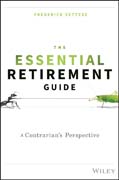
Retirement planning is difficult enough without having to contend with misinformation. Unfortunately, much of the advice that is dispensed is either unsubstantiated or betrays a strong vested interest. In The Essential Retirement Guide, Frederick Vettese analyses the most fundamental questions of retirement planning and offers some startling insights. The book finds, for example that: Saving 10 percent a year is not a bad rule of thumb if you could follow it, but there will be times when you cannot do so and it might not even be advisable to try. Most people never spend more than 50 percent of their gross income on themselves before retirement; hence their retirement income target is usually much less than 70 percent. Interest rates will almost certainly stay low for the next 20 years, which will affect how much you need to save. Even in this low–interest environment, you can withdraw 5 percent or more of your retirement savings each year in retirement without running out of money. Your spending in retirement will almost certainly decline at a certain age so you may not need to save quite as much as you think. As people reach the later stages of retirement, they become less capable of managing their finances, even though they grow more confident of their ability to do so! Plan for this before it is too late. Annuities have become very expensive, but they still make sense for a host of reasons. In addition, The Essential Retirement Guide shows how you can estimate your own lifespan and helps you to understand the financial implications of long–term care. Most importantly, it reveals how you can calculate your personal wealth target – the amount of money you will need by the time you retire to live comfortably. The author uses his actuarial expertise to substantiate his findings but does so in a jargon–free way. INDICE: Preface .Acknowledgments .Chapter 1 The Road to Retirement .Detours .Chapter 2 Doubts about the 70 percent retirement income target .Niggling doubts .Saving for retirement is a 2–dimensional problem .The macro case against 70 percent .Low–income workers .Conclusions .Notes .Chapter 3 Honing in on the Real Target .Setting the ground rules .Howard and Barb .Steve and Ashley 1.0 .Steve and Ashley 2.0 .Expressing consumption in dollars .Conclusions .Chapter 4 A New Rule of Thumb .Guiding principles .Retirement income targets under different scenarios .General rule of thumb .Conclusions .Notes .Chapter 5 Quantifying Your Wealth Target .A rough and ready estimate .A more actuarial approach .Notes .Chapter 6 Why Interest Rates Will Stay Low (And Why You Should Care) .The rise of the savers .The Japan experience .Applicability to the US and Canada .Possible remedies .Implications .Notes .Chapter 7 How Spending Decreases with Age .Doubts .Quantifying the decline in consumption .Why does consumption decline? .Next steps .Notes .Chapter 8 Death Takes a Holiday .Present day life expectancy .Dispersion of deaths .Who is benefiting the most? .Why is mortality improving? .The future .Conclusions .Notes .Chapter 9 Estimating Your Own Life Expectancy .Conclusions .Notes .Chapter 10 Is long–term care in your future? .Long–term care (LTC) .What does LTC entail? .What are the chances you will need LTC? .How long is LTC usually required? .Conclusions .Notes .Chapter 11 Paying for Long–term Care .Typical LTC insurance contract .Does the math work? .The verdict .The consequences of not insuring LTC .Notes .Chapter 12 Putting It All Together .New wealth targets .Buffers .Conclusion .Notes .Chapter 13 Picking a Savings Rate .Historical performance .Lessons learned .What the future holds .Generalizing the results .Notes .Chapter 14 Optimizing Your Savings Strategy .The goal .Strategy 1: Simple .Strategy 2: Simple Lifecycle approach .Strategy 3: Modified Lifecycle .Strategy 4: Variable contribution .Strategy 5: The SMART approach .Conclusions .The Third Lever .Methodology .Chapter 15 A Gentler Approach to Saving .Path 1 – Pain now, gain later on .Path 2 – Smooth and steady improvement .A comparison in dollar terms .Conclusions .Chapter 16 Rational Roulette .Call to action .Watch out for your children .Notes .Chapter 17 Revisiting the 4 Percent Rule .The 4 percent rule .Problems with the 4 percent rule .A more rational spending rule .A Monte Carlo simulation .Conclusions .Chapter 18 Why people hate annuities (but should still buy one) .Why annuities should be popular .The psychology behind the unpopularity .Tontines .The insured annuity strategy .Indexed annuities? Forget it .Conclusions .Notes .Chapter 19 How Workplace Pension Plans fit in .Why employers offer workplace plans .Getting the most out of your workplace plan .How a workplace pension plan affects your dollar target .Online forecast tools .Chapter 20 Bubble Trouble .Why worry about financial bubbles? .Examples of recent financial bubbles .Common Characteristics .The everything bubble .Notes .Chapter 21 Carpe Diem .The numbers .Healthy life years .Trends .Personal genome testing .Notes .Chapter 22 A Life Well Lived .Retirement and happiness .Final thoughts .Notes .Appendix A Similarities between the US and Canada .Social Security programs .High–level comparison of retirement vehicles .A tax comparison .Appendix B Social Security in the US and Canada .Name of Social Security pension plan .Purpose of Social Security .Earnings base for pension calculation .How pension is calculated .How the plans are funded .Normal retirement age .Early retirement age .Delayed retirement .Indexation .Other government–sponsored pension plans .Taxability .Appendix C Retirement income targets under other scenarios .Appendix D About the assumptions used in the book .Thoughts on Conservatism .Assumptions used to estimate personal consumption .Assumptions used to calculate future retirement savings .Assumptions used to estimate the historical accumulation of savings .Couple contemplating long–term care insurance .Assets needed to cover long–term care (LTC) .About the Author .Index
- ISBN: 978-1-119-11112-2
- Editorial: John Wiley & Sons
- Encuadernacion: Cartoné
- Páginas: 288
- Fecha Publicación: 06/01/2016
- Nº Volúmenes: 1
- Idioma: Inglés
